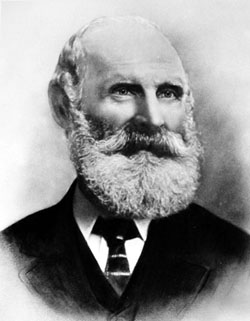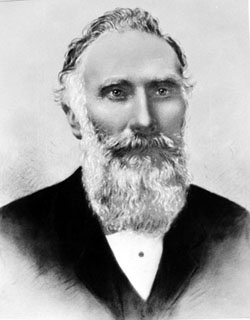| |
| |
|
Peter & David
Duncan |
|
by John Pollard |
|
|
|
David and Peter Duncan were
born on 22 January 1832 and 27 December 1838 at Braidmore farm, near Brechin,
Forfarshire, Scotland, the sons of Ronald Duncan, a farm servant and later
overseer, and his wife, Betty Low. Their trade training was in smithery and
fitting. Peter emigrated to New Zealand, arriving in Lyttelton on the
Lancashire Witch on 13 October 1863. Initially he was in partnership with
Benjamin Cordery, a Lyttelton blacksmith, then from 1865 with Alex
Scrimgeour. On 26 October 1866 Peter Duncan married Jessie Keir in
Christchurch; they were to have at least seven sons and a daughter. The same
year he and Scrimgeour set up a tiny establishment behind a seed shop in
Cashel Street. The partnership dissolved in 1868. Scrimgeour continued
business alongside Duncan, and on becoming bankrupt in 1870 entered his
employment to become fitting-shop foreman.
David Duncan married Ann Bookless Robertson, a domestic servant, at
Montrose, Forfarshire, on 4 June 1858; they were to have two daughters and a
son. After Ann's death in 1864 he married Mary Ann Skene (née Duncan), a
widow, on 31 July 1865 at Craig. They were to have a son. It is not known if
Mary accompanied David Duncan when he emigrated to join his brother. He
arrived at Lyttelton on the Blue Jacket in August 1867.
They were to have a son. It is not known if
Mary |
| |
 |
| |
Peter Duncan |
|
|
accompanied David Duncan
when he emigrated to join his brother. He arrived at Lyttelton on the Blue
Jacket in August 1867. The brothers were partners in 1870 but the name P. &
D. Duncan was not used until 1874. William Boag, an advanced agriculturist
farming at Burnside, encouraged the brothers to repair farm machinery.
Plough making began as a fill-in, but the first was bespoken before
completion. Their uninsured premises were destroyed by fire on Christmas Eve
1869 but friends helped the business to survive and prosper at a site in
Tuam Street. Later a branch was established in Ashburton.
P. & D. Duncan Limited was
incorporated in 1894, with shares being held by the Duncans, their families
and Peter Duncan's brother-in-law, James Keir. David was chairman, Peter
managing director, and both had sons on the salaried staff. The brothers
took no significant part in public affairs apart from being elders of St
Paul's Presbyterian Church. Instead they worked at expanding their company
and developing their reputation as manufacturers of farm machinery. |
 |
|
|
David Duncan |
|
|
In 1870 P. & D. Duncan won
the mayor's cup for the best collection of implements at the Canterbury
Agricultural and Pastoral Association show. By 1876 they had a new
wheelwright and blacksmith shop with eight forges and 40 employees. At the
1883 show they were awarded the president's 40-guinea cup for winning the
largest number of awards in the implement section. Their exhibits included
patent wire strainers, two- and three-furrow ploughs, a sub-soiler for
following the ordinary plough, the turnwrest or hillside plough, light and
heavy grubbers, scarifiers, disc harrows, field rollers and clod crushers,
farm carts and drays, double-furrow ploughs with 'ingeniously contrived
potato planters attached', and a 'giant double furrow plough for heavy and
stony land.' By 1884 there was a drill which could sow either seed or manure
or both together. In 1891 19 forges and 108 employees turned out 330
ploughs, 150 disc harrows, 150 drills, 100 drays and 70 rollers.
The company's greatest achievement during the horse-drawn era was the
manufacture in 1897 of the spring-tooth cultivator. James Keir, valued for
his designing skill in modern machinery and destined to become managing
director, moved from the Ashburton branch to participate in the development.
But even as the brothers attained renown, the Duncan regime drew to an end.
David died at Christchurch on 1 July 1897 and Peter, who retired through ill
health in 1901, died |
|
there on 3 February 1907,
survived by his wife Jessie. Mary Duncan had died in Scotland in 1895. David
Duncan was described as a 'sterling' colonist who had done much to develop
colonial resources, and Peter as 'a kindly, upright, devout Scot,…a sterling
citizen'. After their deaths, several of their sons continued to work for
the company. |
| |
Acknowledgements:
Article: by kind permission of; © Crown Copyright 1996-2007. Published by
the Ministry for Culture and Heritage, Wellington, New Zealand. All rights
reserved http://www.dnzb.govt.nz/
Photograph by Stanley P. Andrew
© Copyright image. All rights reserved. Permission of the Alexander Turnbull
Library, National Library of New Zealand, |
|
|
|


